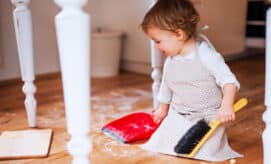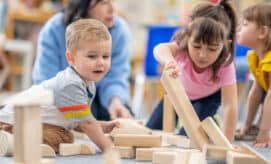While nap time should be relaxing, it often can end up feeling stressful and hectic. NAEYC recommends using the transition to nap time as an opportunity to help children take a break from the day’s activities.
Remember that sticking to a regular and consistent daily routine offers children a sense of security. Children thrive in environments where expectations have been clearly established and they know what to do.
What can you do to create an environment of relaxation and to help release children from the activities and tensions of the day? Read some of NAEYC’s tips below.
Set the Scene
-
The most important thing that you can do to help children unwind is to slow down. When teachers are relaxed, children can relax too.
-
Play peaceful music, keeping the volume low.
-
Talk softly and dim the lights. Shut any curtains or blinds and ensure that no child is sleeping in a place where sun could get in their eyes.
Start at Lunchtime
-
When children finish their meals, allow each child to leave the table and begin to get ready for rest by using the bathroom and washing hands and faces.
-
Make it easy for children to locate the right cot by labeling them with children’s names and pictures so that they can operate with independence.
-
Assist children in getting their bedding and placing it on the cot, if they need help. Sometimes those fitted sheets can be tricky! But allow children an opportunity to try it on their own.
Help Children Relax
-
Give every child a hug, a pat on the back, or a low five. Show them that you cherish and appreciate them.
-
Let children know that the classroom is safe, and that they will be watched over while they close their eyes. Restful sleep is an act of trust.
-
If a child is interested, rub the children’s backs or heads to help them relax. Some children need some extra attention and support to fall asleep.
Read a Comforting Story
-
If you read stories before nap, ensure that the books you are reading create a calm mood in the classroom, with peaceful imagery and words. Moon Dreams, by Ruth Martin, The Napping House, by Audrey Wood, and Time for Bed, by Mem Fox, are three books that convey a sense of warmth and calmness.
Waking Up
-
When children are awake and ready to get up, do not force them to keep resting. Children are learning to listen to and understand their bodies, when they have had enough rest and are ready to be awake.
-
As children awaken, remind them that others are still relaxing, so they need to talk quietly and respect their neighbors who need more rest.
Need a few more tips?
Vanessa Levin of Pre-K Pages wrote an article entitled Nap Time Tips for Preschool Teachers in which she shared her favorite tips for a successful nap time. A few of her suggestions are listed below:
-
Teach skills for nap time throughout the day. Model behavior, talk about expectations, practice how to get ready and how to lay down at other times.
-
Be fully present. Nap time is part of the learning experience for children.
-
Plan ahead. What will you do for children who have difficulty settling down? How will you handle a child who doesn’t nap? Be thoughtful and intentional in all you do.
-
Set realistic expectations. If nap time becomes all about discipline, we must examine our expectations. Assess what you’re doing, adjust, and try again.





